Daihatsu Terios
The Daihatsu Terios (Japanese: ダイハツ・テリオス, Daihatsu Teriosu) is a mini/compact SUV, first released in 1997 by the Japanese car manufacturer Daihatsu as the successor to the F300 series Rocky and Daihatsu Rugger.
| Daihatsu Terios | |
|---|---|
%2C_South_Tangerang.jpg) 2018 Daihatsu Terios R Deluxe (F800RG, Indonesia) | |
| Overview | |
| Manufacturer | Daihatsu |
| Also called |
|
| Production | April 1997 – present |
| Body and chassis | |
| Class |
|
| Body style | 5-door SUV |
| Chronology | |
| Predecessor | Daihatsu Rocky (F300) Daihatsu Rugger |
The name "Terios" is originated from the Old Greek word, which is roughly translated to "making dreams come true".[1][2]
First generation (J100/F500; 1997)
| First generation (J100/F500) | |
|---|---|
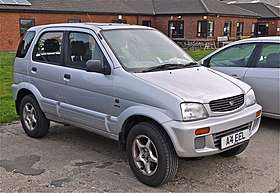 Daihatsu Terios (pre-facelift, UK) | |
| Overview | |
| Also called |
|
| Production |
|
| Assembly |
|
| Layout | |
| Powertrain | |
| Engine | |
| Power output |
|
| Transmission | |
| Dimensions | |
| Wheelbase |
|
| Length |
|
| Width |
|
| Height |
|
| Kerb weight |
|
| Chronology | |
| Successor | Daihatsu Cast Activa (Terios Kid) |
The first generation Terios was available as a five-door wagon, and a smaller kei car model called the Terios Kid, which was only released in Japan. Model codes for the first generation model were J100, J102 and J122. The Terios Kid arrived in October 1998 and continued to be built six years after the original Terios had been replaced.
In 2000, Daihatsu gave the Terios a mild facelift both in the exterior and interior of the vehicle. A new chrome grille replaced the black plastic grille. The high-grade model gained electric front windows, central locking, rear seat head restraints, alloy wheels, roof rails and a roof-mounted rear spoiler. Mechanically, the 1.3-litre SOHC four-cylinder engine fitted to the previous model had been replaced by the new 1.3-litre DOHC four-cylinder engine. Power was also increased by 3 kW (4 hp; 4 PS). A sport version of the K3-VET engine was produced in Japan.
In Australia, a limited edition sports series was introduced in 2001 with only 200 units being available. The vehicle had body colour matching bumpers, different from the two-tone bumper colour on the standard model. Rear spoiler and sunroof became standard. The interior was updated with metallic paint finish on the centre console and dashboard.
This is the first Daihatsu automobile to be assembled in Venezuela, where production began in November 2001.[3][4]
_SX_wagon.jpg) 1999 Daihatsu Terios SX (J100; pre-facelift, Australia)
1999 Daihatsu Terios SX (J100; pre-facelift, Australia)_DX_01.jpg) 2002 Daihatsu Terios DX (J102G; facelift, Australia)
2002 Daihatsu Terios DX (J102G; facelift, Australia)_SX_wagon_(2015-05-29)_01.jpg) 2002 Daihatsu Terios SX (J102G; facelift, Australia)
2002 Daihatsu Terios SX (J102G; facelift, Australia)_SX_wagon_(2015-05-29)_02.jpg) 2002 Daihatsu Terios SX (J102G; facelift, Australia)
2002 Daihatsu Terios SX (J102G; facelift, Australia)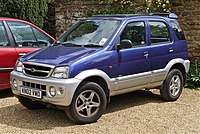 Daihatsu Terios (facelift, UK)
Daihatsu Terios (facelift, UK)
Versions
- Terios (first generation)
- J100G 1997-1999 "HC-EJ" SOHC 1295 cc engine 89 PS (65 kW; 88 hp) 4WD
- J102G 2000-2004 4WD
- engine "K3-VE" DOHC 1297 cc engine 92 PS (68 kW; 91 hp)
- engine "K3-VET" DOHC 1297 cc Turbo engine 140 PS (103 kW; 138 hp)
- J122G 2000-2004 2WD type ( K3-VE / K3-VET )
- Terios Kid (Kei model, available in the Japanese domestic market until May 2012)
- J111G ( EF-DEM ) 1998-2005 Light pressure turbo 658 cc 4WD 60 PS (44 kW; 59 hp)
- J111G ( EF-DET ) 1998-2012 Inter cooler turbo 658 cc 4WD 64 PS (47 kW; 63 hp)
- J131G ( EF-DEM ) 1998-2005 Light pressure turbo 658 cc 2WD 60 PS (44 kW; 59 hp)
- J131G ( EF-DET ) 1998-2012 Inter cooler turbo 658 cc 2WD 64 PS (47 kW; 63 hp)
- Terios Lucia (limited edition)
- J111G / J131G for 2002-2003 only; variation of Terios Kid (without rear-mounted spare tyre)
- Taruna (Indonesia)
- F500RV / F520RV 1999-2001 "HD-C" carburettor / "HD-E" EFI SOHC 1589 cc engine 95 PS (70 kW; 94 hp) / 104 PS (76 kW; 103 hp)
- F501RV / F521RV 2001-2006 "HE-E" EFI SOHC 1498 cc engine 99 PS (73 kW; 98 hp)
Markets
Japan
The first generation Terios is also known as the Toyota Cami (Japanese: トヨタ・キャミ, Toyota Kyami) in Japan.
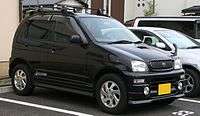 Daihatsu Terios Kid (pre-facelift, Japan)
Daihatsu Terios Kid (pre-facelift, Japan)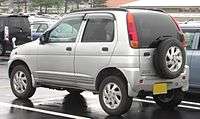 Daihatsu Terios Kid (pre-facelift, Japan)
Daihatsu Terios Kid (pre-facelift, Japan)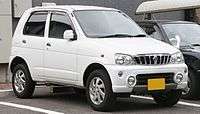 Daihatsu Terios Kid (first facelift, Japan)
Daihatsu Terios Kid (first facelift, Japan)- Daihatsu Terios Kid (first facelift, Japan)
- Daihatsu Terios Kid (second facelift, Japan)
- Daihatsu Terios Kid (second facelift, Japan)
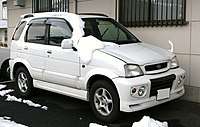 Toyota Cami (pre-facelift, Japan)
Toyota Cami (pre-facelift, Japan)- Toyota Cami (pre-facelift, Japan)
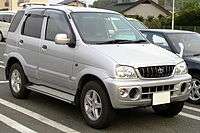 Toyota Cami (facelift, Japan)
Toyota Cami (facelift, Japan)
Malaysia
In Malaysia, the Terios was locally assembled as the Perodua Kembara by Perodua. It was unveiled in August 1998. In June 2003, the Kembara was updated with DVVT engines. In July 2004, the Kembara CT Elegance was unveiled and came with ABS, front dual airbags, leather seats, different designed alloy rim, flat type side step and cubic printing cluster. It was priced at RM59,988 and only available in one colour: Klasik Gold.[6]
%2C_Serdang.jpg) Perodua Kembara (pre-facelift, Malaysia)
Perodua Kembara (pre-facelift, Malaysia)%2C_Serdang.jpg) Perodua Kembara (pre-facelift, Malaysia)
Perodua Kembara (pre-facelift, Malaysia)
Indonesia
In Indonesia, a version of the Terios is known as the Daihatsu Taruna (chassis code: F500/F520), with a different front/rear styling and longer rear-based body capable of seating seven people. The name Taruna translates roughly as "young knight" or "cadet" in Indonesian. The Taruna was launched in July 1999 with a 1589 cc HD-C petrol engine with carburetor. It was initially available in short wheelbase configuration only, the C-series. The engine was later replaced with a 1498 cc HE-E petrol engine with electronic fuel injection in 2001 and the long wheelbase configuration, the F-series, was introduced with the same HD-C engine as the 1999-2001 C-series, and later replaced with the same HE-E engine as the 2001 C-series in the same year. It is available with standard CL and FL trims, deluxe CX and FX trims, and sporty CSX and luxury FGX trims. There are also CSR and FGZ trim levels, which are similar to CSX and FGX, with a 1589 cc HD-E petrol engine with electronic fuel injection.[7]
A refreshed version, called Taruna OXXY, was launched in March 2005.[8]
.jpg) Daihatsu Taruna FL (F521RV; pre-facelift, Indonesia)
Daihatsu Taruna FL (F521RV; pre-facelift, Indonesia)- Daihatsu Taruna FGX (pre-facelift, Indonesia)
China
In China, the Terios was produced under two different brand names: as the Zotye 2008/Hunter and 5008 powered with a 1.5-litre engine from Mitsubishi Motors (first series body); the Zotye was an unauthorized copy of the Terios, which caused some controversy, while FAW badged the Terios as the Huali Terios or Dario.[9][10] In 2009, Daihatsu withdrew from the China market due to bad performance and sold the tooling and rights of this car to First Auto Works (FAW), who was their official joint venture partner in China. Production for the 2008 ran from 2005 to 2010, while the 5008 was produced from 2008 to 2013.
- Zotye 5008 (China)
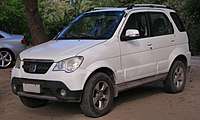 Zotye Hunter (Chile)
Zotye Hunter (Chile)
Second generation (J200/F700; 2006)
| Second generation (J200/F700) | |
|---|---|
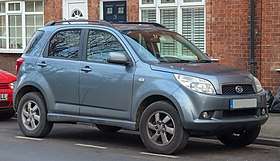 2008 Daihatsu Terios SE (J200RG; pre-facelift, United Kingdom) | |
| Overview | |
| Also called |
|
| Production |
|
| Assembly | |
| Designer | |
| Body and chassis | |
| Layout | |
| Related | Daihatsu Xenia (F600) (F700 model) |
| Powertrain | |
| Engine |
|
| Power output |
|
| Transmission |
|
| Dimensions | |
| Wheelbase |
|
| Length |
|
| Width |
|
| Height |
|
| Kerb weight |
|
| Chronology | |
| Successor |
|
In European, South American and most other Asian markets, the new model is sold under the name Terios. Daihatsu designed and manufacture the Terios and also supplies the vehicle to Toyota under a consigned/OEM manufacturing agreement.[19]
The concept model called D-Compact 4x4 made an appearance in September 2005 at the Frankfurt Motor Show and in November 2005 at the 39th Tokyo Motor Show before being named to Terios, which went into production in January 2006. The model codes are J200, J210 and J211 for the short wheelbase configuration; F700 and F710 for the long wheelbase configuration.
Markets
Japan
For the Japanese market, the first generation Terios was succeeded by the Daihatsu Be‣go (Japanese: ダイハツ・ビーゴ, Daihatsu Bīgo) and the first generation Toyota Rush (Japanese: トヨタ・ラッシュ, Toyota Rasshu).
Both use either 1.3-litre or 1.5-litre engine. Only the 1.5-litre variant is available with both two- or four-wheel drive.
The Terios has a permanent 4WD system via lockable central differential. However, it lacks low ratio gears.
A minor refresh of the Be‣go and Rush was unveiled on 13 November 2008 in Japan. The minor facelift brought redesigned front bumper, tail lamps, alloy wheel design for the G trim and a 5% improvement for fuel economy for the 2WD automatic model.[20] The Be‣go and Rush were discontinued in March 2016 and succeeded by the A200 series Rocky/Toyota Raize crossover in November 2019.[21][22][23][24]
- Daihatsu Be‣go (J200G; pre-facelift, Japan)
- Toyota Rush (J200E; pre-facelift, Japan)
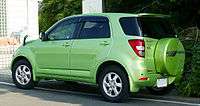 Toyota Rush (J200E; pre-facelift, Japan)
Toyota Rush (J200E; pre-facelift, Japan)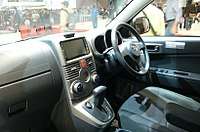 2006 Daihatsu Be‣go interior (Japan)
2006 Daihatsu Be‣go interior (Japan)
South America
In Chile, the second generation Terios in short wheelbase was launched in 2006. It was re-branded as the Toyota Rush in August 2016, as Daihatsu left that market.[25][26]
Indonesia
On 14 December 2006, Daihatsu and Toyota launched the second generation Terios and first generation Rush in Indonesia. Both cars were sold in long wheelbase configuration and rear-wheel drive layout only.[1] The difference between the Terios and Rush: the Terios is designed for seven people and the Rush is designed for five people only, so the Rush lacks third-row seating (although third-row seat is available as a dealer option). Both cars also have different rim design, with seven-spoke wheel from JDM version of the Rush installed on the Terios and five-spoke wheel from European market Terios installed on the Rush. The Terios and Rush received its first facelift on 5 and 6 October 2010, respectively.
At launch in Indonesia, the Terios initially came with four trim levels: TS, TS Extra, TX and TX Adventure. In 2015, the variants were renamed to X, X Extra, R and R Adventure. TS/X and TS/X Extra have some similarities apart from parking sensor, wheel hub and automatic transmission. While Terios TX/R have some more noticeable differences, such as bodykit design (TX/R Adventure) and wheel arches, alloy wheels, spoiler as standard (previous TX trim was optional) and satellite navigation with DVD player double DIN stereo, rear parking camera and HDMI input. The Rush initially came with two trim levels: G and S. The S trim of the Rush was later replaced by the TRD Sportivo trim on 29 August 2013, while the Terios received dual SRS airbags.
On 20 March 2015, the Terios and Rush received its second facelift. The second facelift models brought new projector head lamps with LED positioning lamps, a wider grille with a chrome lower bar, a full-width air intake for the lower bumper and a blacked-out centre piece. For the interior, both Terios and Rush shared the same steering wheel as the F650 series Xenia/Avanza, a redesigned instrument cluster, updated seat upholstery, reshaped second-row headrests and double DIN touchscreen DVD head units on higher trim levels. The trim piece is finished in gloss black for the Terios and silver for the Rush.[27]
On 18 February 2016, the R Custom variant of the Terios was added. On 26 February 2016, the TRD Sportivo Ultimo variant of the Rush (equipped with TRD suspension kit) was launched and the TRD Sportivo 7 variant received an update. Both variants of the TRD Sportivo trim became a seven-seat variant.[28]
Malaysia
In Malaysia, the second generation Terios is available as the Toyota Rush (2008 to 2017) and Perodua Nautica (2008 to 2009).
Toyota Rush
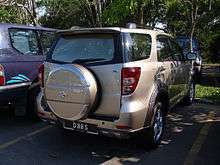
The first generation Rush was launched in Malaysia in January 2008. It is available in two trim levels: 1.5G (with either manual or automatic transmission) and 1.5S (with automatic transmission only). The Rush sold in Malaysia is the long wheelbase in seven-seat configuration.[29]
In December 2010, the Rush received its first facelift for 2011.[30]
In April 2015, the Rush received its second facelift with the same model in the Indonesian market. Exterior changes included redesigned front bumper, radiator grille and bonnet. The bumper is finished in a two-tone effect and the grille is finished with faux carbon-fibre. Elsewhere, there is a new integrated chrome lining highlight running across the headlamp and radiator grille, restyled tail lamps with combination LEDs and smoked lenses. The 1.5S has additional equipment including fog lamps, chrome covers for the wing mirrors, and leather steering wheel and gear knob.[31]
Perodua Nautica
Perodua, Daihatsu's local partner in Malaysia, launched the rebadged version of the short wheelbase Terios, called Nautica in May 2008.[32] This model was fully imported from Japan, except for the front grille, front bumper and rear bumper which are manufactured and fitted in Malaysia. It has a 1.5-litre DVVT engine, full-time 4WD, projector head lamps, and five seats with dark interior. The price tag of the Nautica is not much different from the long wheelbase Rush. It comes with only two colour choices: Medallion Grey and Majestic Black, and comes in automatic transmission only. The Nautica was quietly discontinued in 2009, slightly less than a year after its launch. Only a mere total of 489 units were ever sold.[33] The reason for the discontinuation was because as a national car company focused on local manufacturing, Perodua was unable to obtain sufficient necessary Approved Permits for vehicle importation, as the Nautica was imported in CBU form from Japan.[34]
Safety
2015 Toyota Rush ASEAN NCAP scores:
| Score | Rating | |
|---|---|---|
| Adult Occupant Protection | 12.47/16.00 | |
| Child Occupant Protection | 40.29/49.00 (82%) | |
| Safety Assist | N/A | |
Gallery
Short wheelbase
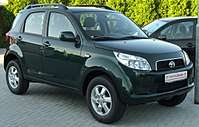 Daihatsu Terios (J200LG; pre-facelift, Germany)
Daihatsu Terios (J200LG; pre-facelift, Germany)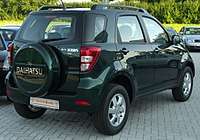 Daihatsu Terios (J200LG; pre-facelift, Germany)
Daihatsu Terios (J200LG; pre-facelift, Germany)- Daihatsu Terios (J200LG; first facelift, Germany)
- Daihatsu Terios (J200LG; first facelift, Germany)
Long wheelbase
%2C_South_Tangerang.jpg) 2007 Daihatsu Terios TX (F700RG; pre-facelift, Indonesia)
2007 Daihatsu Terios TX (F700RG; pre-facelift, Indonesia)%2C_South_Tangerang.jpg) 2011 Daihatsu Terios TS (F700RG; first facelift, Indonesia)
2011 Daihatsu Terios TS (F700RG; first facelift, Indonesia)%2C_South_Tangerang.jpg) 2013 Daihatsu Terios TX (F700RG; first facelift, Indonesia)
2013 Daihatsu Terios TX (F700RG; first facelift, Indonesia).jpg) 2014 Daihatsu Terios TX Adventure (F700RG; first facelift, Indonesia)
2014 Daihatsu Terios TX Adventure (F700RG; first facelift, Indonesia)%2C_South_Tangerang.jpg) 2016 Daihatsu Terios R Adventure (F700RG; second facelift, Indonesia)
2016 Daihatsu Terios R Adventure (F700RG; second facelift, Indonesia)%2C_South_Tangerang.jpg) 2010 Toyota Rush 1.5 S (F700RE; pre-facelift, Indonesia)
2010 Toyota Rush 1.5 S (F700RE; pre-facelift, Indonesia)%2C_South_Tangerang.jpg) 2013 Toyota Rush 1.5 S (F700RE; first facelift, Indonesia)
2013 Toyota Rush 1.5 S (F700RE; first facelift, Indonesia).jpg) 2014 Toyota Rush 1.5 TRD Sportivo (F700RE; first facelift, Indonesia)
2014 Toyota Rush 1.5 TRD Sportivo (F700RE; first facelift, Indonesia)%2C_South_Tangerang.jpg) 2015 Toyota Rush 1.5 G (F700RE; second facelift, Indonesia)
2015 Toyota Rush 1.5 G (F700RE; second facelift, Indonesia)%2C_South_Tangerang.jpg) 2016 Toyota Rush 1.5 TRD Sportivo Ultimo (F700RE; second facelift, Indonesia)
2016 Toyota Rush 1.5 TRD Sportivo Ultimo (F700RE; second facelift, Indonesia)%2C_Batu_City.jpg) 2017 Toyota Rush 1.5 TRD Sportivo (F700RE; second facelift, Indonesia)
2017 Toyota Rush 1.5 TRD Sportivo (F700RE; second facelift, Indonesia)
Third generation (F800/F850; 2017)
| Third generation (F800/F850) | |
|---|---|
%2C_South_Tangerang.jpg) 2018 Daihatsu Terios R (F800RG, Indonesia) | |
| Overview | |
| Also called |
|
| Production | November 2017 – present |
| Assembly | |
| Designer | Mark Widjaja (2015)[36] |
| Body and chassis | |
| Layout | Front-engine, rear-wheel-drive |
| Related | Daihatsu Xenia (F650) |
| Powertrain | |
| Engine | 1.5 L 2NR-VE I4 (petrol) |
| Power output | 76.5 kW (103 hp; 104 PS) |
| Transmission |
|
| Dimensions | |
| Wheelbase | 2,685 mm (105.7 in) |
| Length | 4,435 mm (174.6 in) |
| Width | 1,695 mm (66.7 in) |
| Height | 1,705 mm (67.1 in) |
| Kerb weight | 1,245–1,270 kg (2,745–2,800 lb) |
The third generation Terios was unveiled in Indonesia on 23 November 2017, along with the second generation Rush.[37][38][39][40] The development of the car was led by chief engineer Eiji Fujibayashi in 2015, with its design influenced from the FT Concept.[41][42][43] Unlike previous models, these generation of cars are sold in long wheelbase configuration only and neither the short wheelbase configuration nor four-wheel drive option are offered. It uses the same platform as the long wheelbase version of second generation model, albeit with some tweaks. Compared to their predecessors, the design of the car is more streamlined. It has a rear liftgate rather than a side-opening rear door and no longer has the spare tyre mounted on the rear door.
The model codes are F800 for the Terios/international market Rush and F850 for the Malaysian market Rush/Perodua Aruz.
Markets
Indonesia
The Indonesian market Terios/Rush went on sale on 3 January 2018.[44][45] Both of them are offered only in the seven-seat variant, configured in 2-3-2 layout, with the second row following a 60:40 split, while the third row is 50:50. With the third row backrest folded down, there are 217 L (13,242 cu in) of storage space, which is expanded to 514 L (31,366 cu in) when tumbled up.[46]
The Terios is available in 2 trim levels: X and R. Each trim level can have a Deluxe variant, and later the R trim can also have a Custom variant. The X trim is only available with manual transmission, while the R trim, as well as the X Deluxe, R Deluxe and R Custom variants, are available with either manual or automatic transmission.
The Rush is available in 2 trim levels: 1.5 G and 1.5 TRD Sportivo, with either manual or automatic transmission.
The Terios/Rush comes with LED head lamps and tail lamps, 16-inch alloy wheels, dual airbags, ABS and EBD, 2 DIN touchscreen audio system with six speakers and an air conditioning system with memory function as standard equipment. However, the Rush gains side and curtain airbag (six airbags in total), ESP, hill-start assist, emergency brake signal, engine start/stop button and 7 seatbelt indicators as standard equipment on all variants. The TRD Sportivo trim added body kit cladding, 17-inch alloy wheels, keyless entry, auto climate control air conditioning, leather-wrapped steering wheel, shift knob, dashboard and door trim, coloured instrument panel and 8 speakers setup. The Terios does not equipped with six airbags or seat belt indicators, but it comes with 360-degree around view camera.
Due to high demand, the production of Terios and Rush was also conducted in Astra Daihatsu Motor's Karawang plant alongside the Sunter plant since 2019.[47][48]
In July 2018, the car won the Good Design Indonesia of The Year award.[49][50][51]
In August 2018, during the 26th Gaikindo Indonesia International Auto Show, the R Custom variant of the Terios was added.[52]
Philippines
The Rush was released in the Philippines on 4 May 2018 and is offered in two trim levels: E, which has five seats and is available with either manual or automatic transmission, and G, which has seven seats and is only available with an automatic transmission. The E trim is fitted with 16-inch wheels, chrome grille and foglamp housing, digital climate control system, audio controls on the steering wheel, keyless entry and back up sensors. The G trim is equipped with reverse camera, phone answering button on the steering wheel, 17-inch wheels, blacked out front grille and fog lamp housing, roof rail and smart key entry.
Standard on all trim levels are hill-start assist, ESC, six airbags, ABS, EBD, traction control and LED head lamps.[53][54][55]
Brunei
After the replacement of the first and second generation Terios (sold under Daihatsu badge), the Rush was released in Brunei on 5 May 2018.[56] The car is available in mid or high-grade model lineups, four-speed automatic transmission and seven-seat variant only.
Bangladesh
In Bangladesh, the Rush is only available in one trim level: S, which has 7 seats and 4-speed automatic transmission option only.[57]
United Arab Emirates
The Rush was released in UAE on 14 May 2018.[58][59] Only a seven-seater version is available.
South Africa
The Rush was released in South Africa on 4 July 2018, replaced the previous Daihatsu-badged Terios.[60] It is only available in a five-seat version. It is available in five-speed manual or four-speed automatic options.
Jamaica
The Rush was released in Jamaica on 8 July 2018.[61] Only a seven-seater version is available.
Colombia
The Rush was released in Colombia on 26 July 2018.[62][63][64] Only a seven-seater version is available.
Pakistan
The Rush was unveiled in Pakistan on 31 August 2018. It went on sale on 10 September 2018. Three variants are available and there is only a seven-seat option.[65][66][67]
Malaysia
Toyota Rush
The Rush was launched in Malaysia on 18 October 2018. It is assembled by Perodua as a complete knock-down unit at its plant in Rawang, Selangor. There is only a seven-seat variant. It is only available with a four-speed automatic transmission though two trim levels are available: 1.5 G and 1.5 S.
The 1.5 G trim gets halogen head lamps and fabric seats. While the 1.5 S gets LED head lamps, leather seats, halogen foglamps and a pre-collision system. Both variants get a "R-Blade" bodykit, 17-inch alloy wheels wrapped with 215/60 profile tyres, LED tail lamps, single-zone air-conditioning with rear blower vents, 6.8-inch DVD-AVX head unit with screen mirroring function, multi-info display, Panoramic View Monitor with four cameras, Toyota AutoTag built-in SmartTAG, four electrical outlets, keyless entry and start, digital video recorder (DVR) and 13 cupholders.
The Safe-T Plus safety package includes six airbags, a blind spot monitor with rear-cross traffic alert, ESP and pre-collision system. The pre-collision system operates by first alerting the driver at speeds of 4–100 km/h (2.5–62.1 mph) (vehicles)/4–50 km/h (2.5–31.1 mph) (pedestrians) when an imminent collision is ahead. The system will autonomously apply the brakes (operational speed between 4–80 km/h (2.5–49.7 mph)) to attempt to prevent or mitigate a crash. Also part of the pre-collision system are front departure alert that alerts when the car moves ahead by three metres, and pedal misoperation control. These safety systems, along with traction control, hill-start assist, ABS with EBD and brake assist, and pedal misoperation control contribute to the Rush's five-star ASEAN NCAP safety rating.[46]
Perodua Aruz
.jpg)
.jpg)
.jpg)
The Rush is also sold by Perodua as the Perodua Aruz, which was launched on 15 January 2019.[35] The name "Aruz" is taken from the Malay word "arus", meaning "flow".[68] A media preview occurred in December 2018 while booking opened on 3 January 2019, and since then has made 2,200 bookings at the time of launch.[69][70] There is only a seven-seat version. It is available only with a four-speed automatic transmission though two trim levels are available: 1.5 X and 1.5 AV (Advance). By March 2019, Perodua had successfully delivered 4,000 units of the Aruz with a total booking count at 14,000,[71] and by the beginning of June 2019, roughly 13,000 Aruz had been delivered with a total booking count standing at 25,000.[72]
Safety
| Vehicle Category | SUV | |
|---|---|---|
| Number Of Airbag | 6 | |
| Score | Rating | |
| Overall | 85.42/100.00 | |
| Adult Occupant Protection | 31.14/36.00 | |
| Frontal Impact | 12.50/16.00 | |
| Side Impact | 14.64/16.00 | |
| Head Protection Technology | 4.00/4.00 | |
| Child Occupant Protection | 41.81/49.00 | |
| Frontal Impact | 16.00/16.00 | |
| Side Impact | 8.00/8.00 | |
| Safety Assist | 15.00/18.00 | |
| Effective Braking & Avoidance | 8.00/8.00 | |
| Seatbelt Reminders | 6.00/6.00 | |
| Blind Spot Technology | - | |
| Advanced SATs | 1.00/2.00 | |
| Vehicle Category | SUV | |
|---|---|---|
| Number Of Airbag | 6 | |
| Score | Rating | |
| Overall | 86.49/100.00 | |
| Adult Occupant Protection | 31.14/36.00 | |
| Frontal Impact | 12.50/16.00 | |
| Side Impact | 14.64/16.00 | |
| Head Protection Technology | 4.00/4.00 | |
| Child Occupant Protection | 41.19/49.00 | |
| Frontal Impact | 16.00/16.00 | |
| Side Impact | 8.00/8.00 | |
| Safety Assist | 16.00/18.00 | |
| Effective Braking & Avoidance | 8.00/8.00 | |
| Seatbelt Reminders | 6.00/6.00 | |
| Blind Spot Technology | - | |
| Advanced SATs | 2.00/2.00 | |
Recalls
On 15 July 2019, Toyota had announced that around 60,000 units of the Indonesian market Rush manufactured from December 2017 to February 2019 would be recalled due to a problem regarding the airbags. It is stated that the affected models were found to have an improperly programmed airbag control module which could cause the side curtain airbags to accidentally deploy even when the vehicle is running normally. An impact on the rear wheel when passing a pothole or dent may be misinterpreted as a collision, which may cause deployment of the side curtain airbags. The Terios models were not affected due to the fact that the model is not being equipped with side curtain airbags.[75][76][77][78][79][80]
Gallery
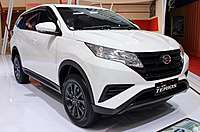 2018 Daihatsu Terios X Deluxe (F800RG, Indonesia)
2018 Daihatsu Terios X Deluxe (F800RG, Indonesia)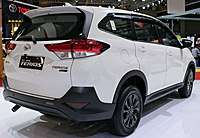 2018 Daihatsu Terios X Deluxe (F800RG, Indonesia)
2018 Daihatsu Terios X Deluxe (F800RG, Indonesia)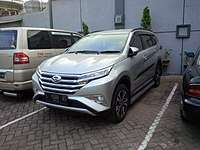 2018 Daihatsu Terios R (F800RG, Indonesia)
2018 Daihatsu Terios R (F800RG, Indonesia)%2C_West_Surabaya.jpg) 2019 Daihatsu Terios R (F800RG, Indonesia)
2019 Daihatsu Terios R (F800RG, Indonesia)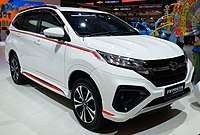 2018 Daihatsu Terios R Custom (F800RG, Indonesia)
2018 Daihatsu Terios R Custom (F800RG, Indonesia)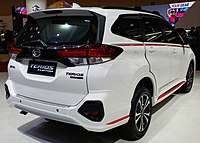 2018 Daihatsu Terios R Custom (F800RG, Indonesia)
2018 Daihatsu Terios R Custom (F800RG, Indonesia)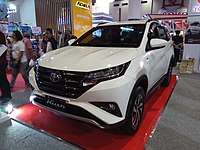 2019 Toyota Rush 1.5 G (F800RE, Indonesia)
2019 Toyota Rush 1.5 G (F800RE, Indonesia)%2C_West_Surabaya_(cropped).jpg) 2019 Toyota Rush 1.5 G (F800RE, Indonesia)
2019 Toyota Rush 1.5 G (F800RE, Indonesia).jpg) 2018 Toyota Rush 1.5 S (F800RE, Laos)
2018 Toyota Rush 1.5 S (F800RE, Laos)_(cropped).jpg) 2018 Toyota Rush 1.5 S (F800RE, Laos)
2018 Toyota Rush 1.5 S (F800RE, Laos).jpg) 2018 Toyota Rush 1.5 TRD Sportivo (F800RE, Indonesia)
2018 Toyota Rush 1.5 TRD Sportivo (F800RE, Indonesia)%2C_Ciater%2C_Subang.jpg) 2019 Toyota Rush 1.5 TRD Sportivo (F800RE, Indonesia)
2019 Toyota Rush 1.5 TRD Sportivo (F800RE, Indonesia).jpg) 2018 Toyota Rush 1.5 TRD Sportivo interior (Indonesia)
2018 Toyota Rush 1.5 TRD Sportivo interior (Indonesia).jpg) 2NR-VE engine in the Toyota Rush
2NR-VE engine in the Toyota Rush_01.jpg) Daihatsu FT Concept
Daihatsu FT Concept
Sales
By the end of 2002, Daihatsu sold 33,000 units of Terios and 97,000 units of Terios Kid.[81]
| Calendar Year | Indonesia | Malaysia | Philippines | ||
|---|---|---|---|---|---|
| Daihatsu Terios | Toyota Rush | Toyota Rush | Perodua Aruz | Toyota Rush | |
| 2014 | 29,609[82] | ||||
| 2015 | 26,848[82] | ||||
| 2016 | 24,371[83] | ||||
| 2017 | 10,344[84] | 20,039[85] | |||
| 2018 | 31,453[86] | 53,145[86] | |||
| 2019 | 22,960[87] | 61,569[87] | 2,848 | 30,115[88] | 15,172[89] |
References
- "PT Astra Daihatsu Motor Luncurkan Daihatsu Terios" [PT Astra Daihatsu Motor launches the Daihatsu Terios]. Daihatsu Press Release (in Indonesian). PT. Astra Daihatsu Motor. 14 December 2006. Archived from the original on 10 January 2007.
- https://jip.gridoto.com/read/05221072/wah-ternyata-ini-arti-nama-daihatsu-terios?page=all#!%2F
- "Annual Report 2002" (PDF). Osaka, Japan: Daihatsu Motor Co. March 2002. p. 14. Archived from the original (PDF) on 18 December 2010.
- https://www.daihatsu.com/news/2001/01112201.html
- "Toyota and Daihatsu to Increase Production Capacity in Indonesia" (Press release). Daihatsu. 26 April 2005. Archived from the original on 24 June 2016. Retrieved 22 August 2019.
- "Perodua :: News & Events :: 2004". 16 April 2007. Archived from the original on 16 April 2007. Retrieved 3 September 2017.CS1 maint: BOT: original-url status unknown (link)
- https://jip.gridoto.com/read/261788446/daihatsu-taruna-kenalan-sama-perintis-suv-7-seater-di-indonesia?page=all#!%2F
- "Peluncuran Taruna OXXY" [Launch of the Taruna OXXY]. Daihatsu Press Release (in Indonesian). PT. Astra Daihatsu Motor. 24 March 2005. Archived from the original on 26 August 2007.
- "FAW.com". FAW. Archived from the original on 14 January 2016.
- "活力小子:紧凑型SUV TERIOS 来了(多图)". Wood (in Chinese). Sohu.com. 4 October 2003. Archived from the original on 17 April 2004.
- "New compact SUV from Premier Auto. EDIT: Rio quick testdrive on page 10". Team-BHP.com. Retrieved 18 February 2020.
- https://www.daihatsu.com/company/facilities/
- https://pdki-indonesia.dgip.go.id/index.php/di/Ui9KOVMxTm1jSDYrZzdXQ0xmdzR1QT09?q=mobil&type=1&skip=40
- https://pdki-indonesia.dgip.go.id/index.php/di/QXlsQml0cVMzVnpWa2JMMnBIVTEvdz09?q=mobil&type=1&skip=70
- "Mark Widjaja, Mobil dengan Simple Design Tak Pernah Usang" [Mark Widjaja: A Car with Simple Design Never Gets Old]. Otomotif (in Indonesian). Indonesia. 13 September 2011. Retrieved 15 July 2019.
- https://oto.detik.com/berita/3368672/desain-mobil-sampai-berdarah-darah?ot1208dtl=
- https://otomotif.okezone.com/read/2012/11/06/52/714167/sttt-desainer-ayla-pernah-tak-naik-kelas
- https://biz.kompas.com/read/2018/04/09/190000428/mengenal-sosok-desainer-lokal-di-balik-yaris-trd-sportivo
- "Daihatsu 2010 Annual Report" (PDF). Archived from the original (PDF) on 3 March 2016. Retrieved 20 October 2011.
- "2009 Toyota Rush Facelift unveiled in Japan". Paul Tan's Automotive News. 15 November 2008. Retrieved 28 July 2017.
- https://tech.nikkeibp.co.jp/atcl/nxt/column/18/01046/
- https://response.jp/article/2019/11/05/328386.html
- https://paultan.org/2019/10/23/tokyo-2019-daihatsu-previews-new-compact-suv-is-this-an-early-look-at-peroduas-d55l-b-segment-suv/
- https://www.liputan6.com/otomotif/read/4093334/daihatsu-rocky-bangkit-lagi-ini-wujudnya
- Nuñez, Beatriz (8 August 2016). "Daihatsu Terios Bego pasa a ser Toyota Rush". PuroMotor (in Spanish). Retrieved 3 September 2019.
- Beher, Jorge (8 September 2016). "Toyota lanza el Rush y liquida a Daihatsu en Chile". autocosmos.com (in Spanish). Retrieved 3 September 2019.
- "Toyota Rush, Daihatsu Terios facelift now in Indonesia". Paul Tan's Automotive News. 21 March 2015. Retrieved 28 July 2017.
- "Updated 2016 Toyota Rush 7 launched in Indonesia". Paul Tan's Automotive News. 29 February 2016. Retrieved 28 July 2017.
- "New 7-seater Toyota Rush SUV launched!". Paul Tan's Automotive News. 29 January 2008. Retrieved 28 July 2017.
- "Toyota Rush updated for 2011 with darker interior". Paul Tan's Automotive News. 10 December 2010. Retrieved 30 July 2017.
- "2015 Toyota Rush facelift introduced in Malaysia". Paul Tan's Automotive News. 24 April 2015. Retrieved 28 July 2017.
- https://paultan.org/2008/05/09/perodua-nautica-4wd-specifications-and-photos/
- "Malaysian Automotive Association Total Industry Volume". Cite journal requires
|journal=(help) - "Perodua Nautica: official name for new Perodua SUV". Paul Tan's Automatic News. 24 April 2008. Retrieved 19 March 2019.
- Lye, Gerard (15 January 2019). "2019 Perodua Aruz SUV launched in Malaysia – seven seats; ASA 2.0; two variants; RM72,900 and RM77,900". Paul Tan's Automotive News. Retrieved 15 January 2019.
- https://nasional.tempo.co/read/1142330/berlaga-di-ajang-good-design-award-jepang-produk-indonesia-sukses-sabet-gelar
- "All New Terios Meluncur, Begini Perubahannya". Kompas.com. 23 November 2017. Retrieved 23 November 2017.
- "Ini Dia Generasi Terbaru Toyota Rush". Kompas.com. 23 November 2017. Retrieved 23 November 2017.
- "New 2018 Toyota Rush SUV makes debut in Indonesia". Paul Tan's Automotive News. 23 November 2017. Retrieved 23 November 2017.
- "New 2018 Daihatsu Terios makes debut in Indonesia". Paul Tan's Automotive News. 23 November 2017. Retrieved 23 November 2017.
- https://www.merdeka.com/otomotif/sayang-sekali-rd-all-new-rush-terios-dilakukan-di-jepang.html
- https://www.carmudi.co.id/journal/toyota-all-new-rush-hasil-pengembangan-dari-ft-concept/
- https://www.autoevolution.com/news/2018-daihatsu-terios-revealed-along-with-all-new-toyota-rush-121864.html
- "2018 Toyota Rush Indonesia pricing revealed – no increase despite higher specs, from RM72k-RM78k". Paul Tan's Automotive News. 3 January 2018. Retrieved 4 February 2018.
- "2018 Daihatsu Terios pricing announced in Indonesia – RM58k to RM74k, most variants cheaper than before". Paul Tan's Automotive News. 4 January 2018. Retrieved 4 February 2018.
- https://paultan.org/2018/10/18/2018-toyota-rush-launched-in-malaysia/
- Purnama, Rayhand. "Hindari Inden Lama, Produksi Terios dan Rush Dipisah". teknologi (in Indonesian). Retrieved 3 February 2020.
- fea. "Inden Terios Sampai 3 Bulan, Pabrikan Tambah Jalur Produksi". teknologi (in Indonesian). Retrieved 3 February 2020.
- http://www.beritasatu.com/ekonomi/502094-daihatsu-terios-raih-gelar-good-design-indonesia-of-the-year-2018.html
- http://otomotif.bisnis.com/read/20180721/46/819096/lsuv-terios-raih-good-design-indonesia-of-the-year
- http://carreview.id/news/daihatsu-terios-raih-good-design-indonesia-2018-dari-kementrian-perdagangan/12127
- http://otodriver.com/article/view/giias-2018-daihatsu-terios-dapat-varian-baru-bodi-lebih-sporty/VmTOJ47chdTtLAdst8fSr-TcASdiLEELDOjNC4GHaXY
- "Toyota PH launches all-new Rush SUV". motioncars.inquirer.net.
- "2018 Toyota Rush launched in the Philippines - Indian Autos blog". 7 May 2018.
- "Toyota rolls out much-awaited Rush".
- "All-new Toyota Rush makes Brunei debut – Borneo Bulletin Online". 5 May 2018.
- "13 cup holders, 2 men and a Toyota Rush". 15 May 2019.
- "Toyota Rush launched at Dubai's Palazzo Versace – in pictures".
- "Al-Futtaim Toyota launches new compact SUV". www.tradearabia.com.
- https://www.wheels24.co.za/NewModels/toyota-debuts-stylish-rush-suv-heres-how-much-the-baby-fortuner-costs-in-sa-20180704
- http://jamaica-gleaner.com/article/auto/20180708/toyota-jamaica-expecting-drivers-rush-new-vehicle
- http://www.eluniversal.com.co/autos/toyota-lanza-en-cartagena-una-nueva-propuesta-rush-283728
- http://www.elcolombiano.com/tendencias/sin-prisa-e-ideal-para-terrenos-agrestes-DA9255849
- https://indianautosblog.com/2018/08/india-waits-toyota-rush-heads-colombia-312875
- https://www.thenews.com.pk/print/361717-imc-unveils-new-toyota-rush
- https://www.pakwheels.com/blog/toyota-rush-2018-3-variants/
- https://www.researchsnipers.com/toyota-rush-launched-in-pakistan-with-three-variants/
- https://paultan.org/2019/01/03/perodua-aruz-suv-explanation-behind-the-new-name/
- "Perodua Aruz SUV – full spec-by-spec comparison". Paul Tan's Automotive News. 3 January 2019. Retrieved 3 January 2019.
- https://paultan.org/2019/01/15/perodua-aruz-2200-bookings-received-since-jan-3/
- "Perodua Aruz - 14,000 bookings, 4,000 units delivered". Paul Tan's Automotive News. 18 March 2019. Retrieved 8 May 2019.
- "Perodua Has Fulfilled 52% Of Its Aruz Deliveries - Auto News - Carlist.my". Carlist.my - Malaysia's No.1 Car Site. Retrieved 3 June 2019.
- "TOYOTA RUSH (2018)". Aseancap. 7 May 2018. Retrieved 30 June 2020.
- "PERODUA ARUZ". Aseancap. 15 January 2019. Retrieved 30 June 2020.
- https://www.autoindustriya.com/auto-industry-news/toyota-ph-to-issue-recall-for-rush-suv.html
- https://www.autoindustriya.com/auto-industry-news/toyota-ph-recalls-rush-potholes-rough-roads-can-trigger-airbags.html
- https://otomotif.kompas.com/read/2019/07/15/115121215/airbag-bermasalah-toyota-recall-60000-rush-di-indonesia
- https://oto.detik.com/mobil/d-4624562/airbag-berpotensi-masalah-toyota-recall-60000-unit-rush
- https://otomotif.kompas.com/read/2019/07/15/122200815/rush-kena-recall-apa-kabar-terios
- https://oto.detik.com/mobil/d-4624756/toyota-rush-ditarik-daihatsu-terios-aman
- "Terios to Be Produced in China Under New Technical Licence Agreement with FAW Huali (24 Jan 2003)" (Press release). Daihatsu. 24 January 2003. Retrieved 13 January 2018.
- Media, Kompas Cyber (21 January 2016). "Mobil Terlaris Sepanjang 2015 - Kompas.com". Retrieved 7 December 2018.
- Kuswaraharja, Dadan. "20 Mobil Terlaris di Indonesia Tahun 2016". Retrieved 7 December 2018.
- https://www.gaikindo.or.id/data-gaikindo-avanza-terlaris-sepanjang-2017/
- Kuswaraharja, Dadan. "20 Mobil Terlaris Tahun 2017". Retrieved 7 December 2018.
- https://kendara.id/sales-report-mobil-indonesia-jan-des-2018/
- Rahadiansyah, Rangga (23 January 2020). "20 Mobil Terlaris 2019" [20 of Indonesia's Best Selling Cars in 2019]. Detik.com (in Indonesian). Indonesia: Trans Media. Retrieved 24 January 2020.
- "Top 10 best-selling car models in Malaysia in 2019". Paul Tan's Automotive News. 6 February 2020. Retrieved 8 February 2020.
- Sarne, V. Vernon B. "Toyota PH reveals 2019 per-model sales breakdown". visor.ph. Retrieved 8 February 2020.
External links
- Official website (Indonesia)
|
|